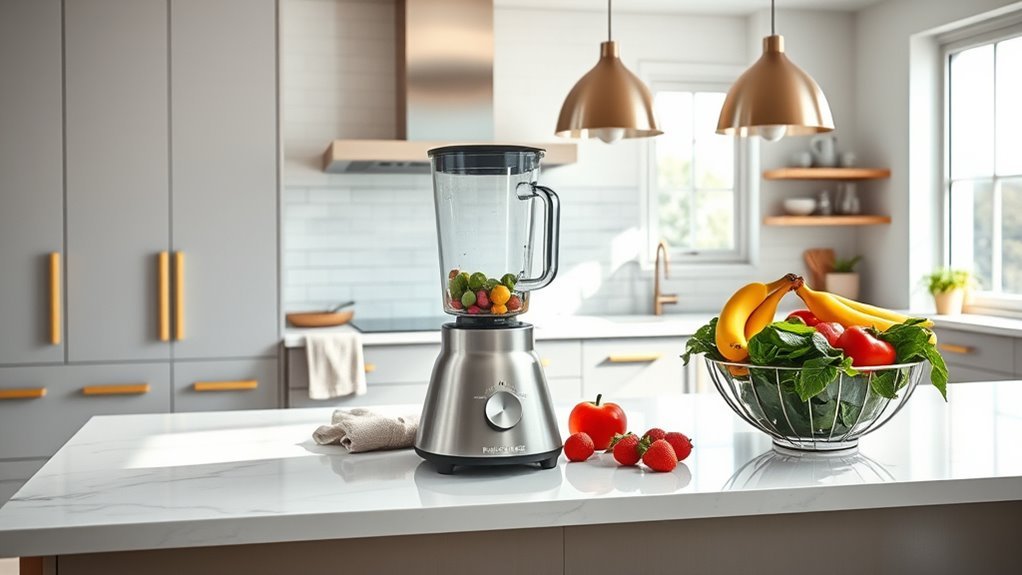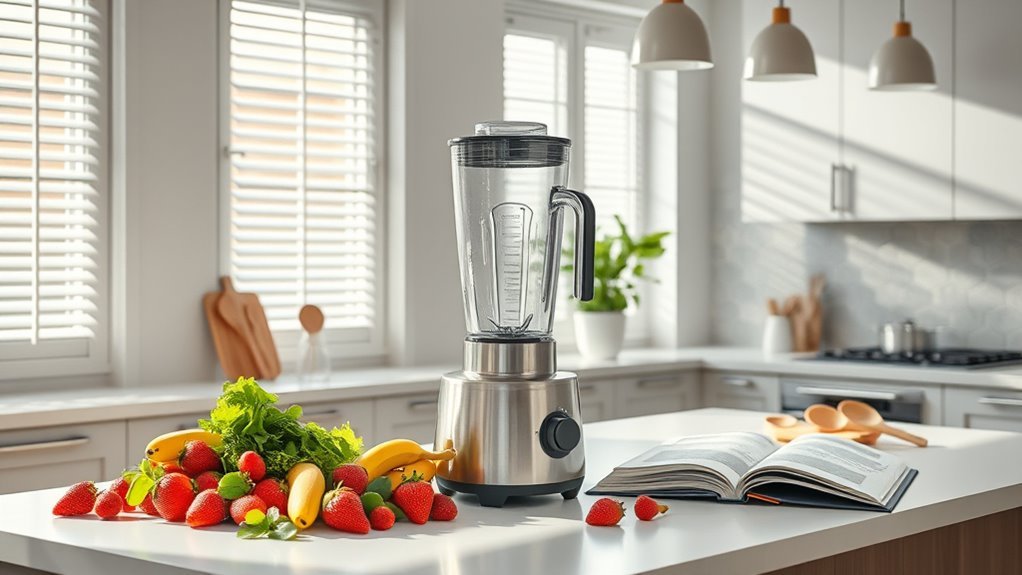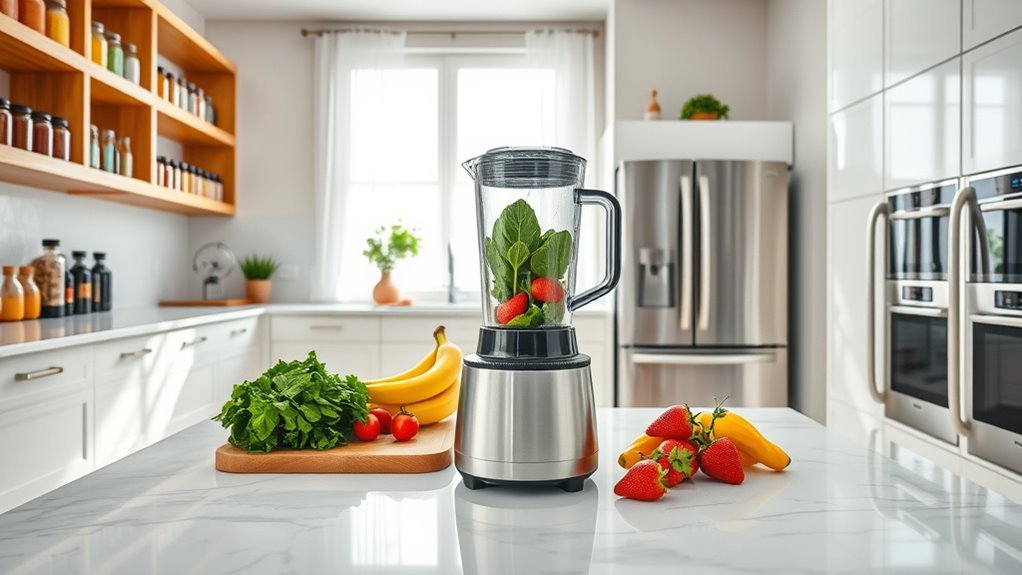We’ve cracked the code on stubborn blender stains with these proven pro techniques. Start with immediate hot water rinsing after each use – it’s non-negotiable. For deep cleaning, combine lemon juice with baking soda, or try our vinegar-based solution for tough buildup. Ice cube scrubbing tackles protein residue, while weekly maintenance prevents long-term discoloration. Combat odors with fresh lemon juice blends. These battle-tested methods are just the beginning of your stain-fighting arsenal.
The Power of Immediate Rinsing

When it comes to conquering blender stains, immediate rinsing isn’t just helpful – it’s essential. We’ve seen countless blender jars ruined by procrastination, but here’s the truth: those first few minutes after use are golden. A quick hot water rinse stops food particles from becoming tomorrow’s stubborn stains.
Let’s be clear – we’re not talking about a full cleaning routine here. What we’re advocating is a strategic pre-emptive strike. Run hot water through your blender right after use, and you’ll prevent those frustrating stuck-on bits from becoming permanent residents. High-performance blenders, with their powerful motors and durable designs, can handle this quick rinse without any worry of damage.
It’s especially vital for those protein shakes and berry smoothies that love to leave their mark. Plus, you’ll neutralize lingering odors and save yourself from the nightmare of scrubbing dried-on debris later.
Lemon and Baking Soda Magic Formula
Beyond quick rinsing, there’s a powerhouse cleaning combo that’ll tackle even the most stubborn blender stains. The secret? Our foolproof lemon and baking soda formula.
| Step | Action |
|---|---|
| 1 | Juice one fresh lemon into blender |
| 2 | Add 2 tablespoons baking soda |
| 3 | Pour in 1 cup water |
| 4 | Blend on high for 30 seconds |
| 5 | Wipe with soft sponge |
Watch the science unfold as lemon juice meets baking soda, creating a fizzing reaction that lifts away trapped particles. This dynamic duo breaks down residue while naturally deodorizing your blender. After the blend cycle, a quick once-over with a soft sponge removes any stragglers. Rinse thoroughly with clean water, and you’re ready for your next culinary adventure. No chemicals, no fuss – just pure cleaning power. Additionally, maintaining your blender properly can significantly enhance its longevity, ensuring it stays in top shape for years to come with proper care and maintenance.
Vinegar-Based Deep Cleaning Solution

For blenders plagued with persistent stains, our vinegar-based deep cleaning solution packs a serious punch.
Let’s combine 3/4 cup white vinegar, 1/4 cup baking soda, and 1/4 cup water – watch that satisfying fizz work its magic on those stubborn stains.
Here’s the deal: blend this powerful mixture on high for 30 seconds. The chemical reaction between vinegar and baking soda breaks down those annoying food particles you thought would never budge.
We’ll want to follow up with a quick scrub using a soft sponge – no exceptions.
Don’t skip the thorough rinse afterward. Trust us, you don’t want cleaning solution residue in tomorrow’s smoothie.
Use this method regularly, and you’ll keep those persistent stains from becoming permanent residents in your blender.
Ice Cube Scrubbing Method
Although most cleaning methods require specialized solutions, this ice cube trick‘s pure genius lies in its simplicity.
We’re going to harness the power of frozen water to obliterate those stubborn stains that mock your cleaning efforts.
Here’s the magic: Toss a handful of ice cubes into your blender, add a squirt of dish soap, and splash in some water. Hit that high-speed button and let it rip for 30 seconds. The ice acts like nature’s scrub brush, while the cold temperature freezes residue for easier removal.
When you’re done, just rinse with warm water and marvel at the results.
Make this your go-to cleaning routine. We’ve found it’s particularly effective at maintaining your blender’s pristine condition and preventing long-term buildup. No fancy cleaners needed.
Natural Stain-Fighting Alternatives

When chemical cleaners fail to deliver, nature’s own cleaning agents pack a powerful one-two punch against blender stains.
Let’s activate the cleaning effectiveness of baking soda by creating a paste with water – it’s your new best friend for tackling stubborn stains.
Need extra firepower? Add white vinegar to create an unstoppable fizzing reaction that demolishes grime.
We’ve got another ace up our sleeve: fresh lemon juice. It’s perfect for freshening up your blender while cutting through greasy buildup.
For maximum impact, combine these natural ingredients strategically – try one cup of vinegar with half a cup of baking soda. This dynamic duo will obliterate even the most persistent stains.
Hot Water Blending Technique
Natural cleaners work wonders, but let’s level up our blender-cleaning game with the hot water blending technique. This powerhouse cleaning method tackles stubborn stains with minimal effort – just hot water, dish soap, and your blender’s motor doing the heavy lifting.
Here’s our foolproof process:
- Fill your blender halfway with hot water and add a few drops of dish soap.
- Secure the lid tight and cover with a towel (safety first!).
- Blend on high for 10 seconds, then pulse for extra-stubborn residue.
- Rinse thoroughly with hot water until soap-free.
We love this technique because it’s lightning-fast and reaches those annoying nooks where smoothie remnants love to hide.
Plus, it’ll keep your blender performing like new by preventing buildup and funky odors.
Weekly Descaling Process
Since your blender’s working hard for you daily, we’ll show you how to return the favor with a weekly deep-clean that’ll keep it running like new.
Let’s tackle those stubborn stains with our foolproof descaling method. Mix 1 cup of vinegar with ½ cup of baking soda – trust us, the fizzing reaction is exactly what you want.
Blend this powerhouse solution on high for 30 seconds, letting it work its magic on every surface. Give it 10-15 minutes to sit and demolish those persistent stains.
Rinse thoroughly with warm water until every trace of cleaning solution vanishes. Want extra credit? Add a final blend with lemon and water to eliminate lingering odors.
Your blender will thank you with spotless performance week after week.
Preventing Color Transfer Stains
Those vibrant smoothie ingredients that pack such nutritional punch can leave your blender looking like a Jackson Pollock painting.
Let’s tackle preventing color transfer stains head-on with proven techniques that work.
First, we’ll leverage common household ingredients and smart habits to keep your blender pristine:
- Switch to a glass blender jar – it’s naturally stain-resistant and won’t absorb colors like plastic.
- Add water or ice when blending vibrant ingredients to dilute those stubborn pigments.
- Clean immediately after use – don’t let those colors set in.
- Make baking soda your best friend for regular cleaning – it neutralizes both stains and odors.
For frequent blenders, consider investing in a protective jar liner.
Trust us, your smoothie-making future will be brighter – without the rainbow-colored evidence.
Tackling Protein Smoothie Residue
Three major challenges make protein smoothie residue a nightmare: it dries like cement, creates stubborn films, and loves to hide in blender crevices.
Let’s tackle this head-on.
First rule: Never let protein residue dry. Rinse with warm water immediately after use – we’re talking seconds, not minutes.
For stuck-on residue, our magic weapon is a baking soda paste. Apply it, wait, then scrub.
Still fighting gunk? Blend hot water with dish soap and a splash of lemon juice.
The ultimate nuclear option? Mix vinegar and baking soda for a fizzing cleaning action that’ll strip away even the most stubborn protein films.
Prevention beats cleanup every time.
We recommend weekly deep cleaning sessions: warm water, baking soda, and vinegar. Your blender will thank you.
Professional-Grade Cleaning Hacks
While home remedies work fine, professional-grade cleaning techniques take blender maintenance to the next level.
Let’s explore these game-changing cleaning hacks that’ll transform how you tackle stubborn stains.
- Create our ultimate power-clean mixture: Blend 3/4 cup vinegar, 1/4 cup baking soda, and 1/4 cup water for 30 seconds – watch that grime dissolve.
- Combat odors by blending fresh lemon juice with water after each use, especially essential for protein shakes.
- Fight discoloration by immediately rinsing after dark ingredients, preventing those micro-scratches from becoming stain magnets.
- Attack tough residue with the fizz method: Sprinkle baking soda directly on problem areas, pour vinegar over it, and let chemistry do the heavy lifting before scrubbing with a soft sponge.
Frequently Asked Questions
How to Remove Blender Stains?
Let’s tackle blender stains with eco-friendly cleaners like vinegar and baking soda paste, or try our daily maintenance routine of warm soapy water. Deep cleaning techniques guarantee lasting stain prevention.
How to Remove Calcified Hard Water Stains?
Like warriors battling mineral deposits, we’ll conquer hard water stains with vinegar’s acidic powers, followed by baking soda’s grit. Regular maintenance and filtered water prevent future calcium buildup.
Are Old Stains Impossible to Remove?
We’ve found that old stains aren’t impossible to remove. With effective cleaning tips and natural cleaning solutions, even stubborn stains can be eliminated. Regular blender maintenance and prevention strategies guarantee lasting cleanliness.
How to Remove Yellow Stains From Blender?
Like bringing sunshine back to cloudy plastic, we’ll tackle yellow stains using baking soda paste, vinegar solutions, or lemon juice. Regular maintenance and quick rinsing prevent future discoloration.

